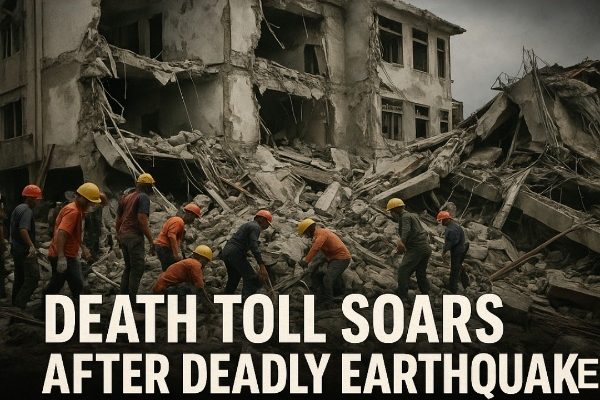The Philippines has been thrust into mourning and chaos after a powerful earthquake ripped through the central island of Cebu late Tuesday night, leaving more than 60 people confirmed dead and hundreds injured. The 6.9-magnitude tremor, described as shallow and particularly destructive, struck just before 10 p.m. local time, jolting residents from their homes and sending terrified families fleeing into the dark streets. The United States Geological Survey (USGS) reported the quake hit near Bogo City, a coastal community of around 90,000 residents.
The damage was immediate and widespread. In Cebu City alone, officials confirmed at least 31 deaths, while surrounding towns and provinces reported dozens more fatalities. Entire neighborhoods were flattened, schools collapsed under the weight of their concrete roofs, and small shops crumbled as if made of sand. Authorities warned grimly that the death toll would almost certainly rise in the coming days as rescuers continued to pull bodies and survivors alike from the wreckage.
Eyewitnesses described scenes of pure terror. “The ground shook like it was alive,” said Maricel Santos, a 42-year-old mother of three who ran barefoot with her children into the street as their home cracked behind them. “It felt like the earth was trying to swallow us whole. The walls collapsed seconds after we got out. If we had waited, we’d be gone.” Others recalled watching power lines whip violently, sparks raining down as transformers exploded. Whole districts were plunged into darkness, with the only illumination coming from flashlights, candles, and the headlights of cars stuck on fractured roads.
The chaos was compounded by power outages and communication failures. Cell towers buckled, leaving many communities isolated and unable to call for help. Damaged highways made it nearly impossible for rescuers to reach some of the hardest-hit areas, forcing military helicopters and boats to be deployed in the first desperate hours. In rural villages, survivors used their bare hands and makeshift tools to claw through rubble in search of neighbors and relatives, their shouts and cries cutting through the eerie silence after the quake.
Emergency services, already stretched thin, moved quickly to mobilize. Thousands of soldiers and volunteers joined local firefighters and paramedics in a frantic race against time. The national disaster agency described the effort as “all hands on deck,” with aid pouring in from nearby provinces. Tents were set up outside hospitals to handle the overflow of injured. Makeshift triage centers dotted open fields, where doctors worked under floodlights powered by generators.
One exhausted rescue worker, his face streaked with dust and sweat, summed up the situation bluntly: “We are racing against time. Every hour matters. People are still trapped. We hear voices under the rubble, and we won’t stop until we bring them out—alive or dead.”
Among the most heartbreaking stories emerging were those of children caught in collapsing schools. In northern Cebu, a small elementary school buckled under the force of the quake. Teachers and volunteers managed to pull some students out, but several others remain missing. In nearby towns, churches that once served as places of safety became death traps, their stone walls reduced to piles of debris.
Survivors who escaped with their lives now face new dangers. With water lines shattered and food supplies cut off, thousands are gathering in makeshift shelters, bracing themselves for aftershocks that experts warn could continue for weeks. Families huddle together on mats laid over cracked asphalt, clutching bags of clothes or photographs salvaged from their destroyed homes. Many speak of their fear of sleeping indoors again.
“I don’t care if we never go back into the house,” said Ernesto Cruz, who lost his cousin when their grocery shop collapsed. “We’ll sleep outside. The earth can shake anytime. We’ll never feel safe again.”
The quake’s impact also reignited a long-standing debate in the Philippines about infrastructure safety and preparedness. The archipelago sits squarely on the Pacific “Ring of Fire,” a region notorious for earthquakes, tsunamis, and volcanic eruptions. Experts have long warned that many buildings, particularly in provincial areas, are not built to withstand powerful tremors. While some newer high-rises in Cebu City survived with minimal damage, countless older structures toppled instantly.
“This is not just a natural disaster,” said an engineer from Manila’s Institute of Seismology and Volcanology. “It is a reminder of how vulnerable we are because of poor construction standards. Until we enforce stricter codes and retrofit older buildings, tragedies like this will continue.”
International aid organizations are already preparing to step in. The Red Cross has deployed teams to provide emergency shelter, clean water, and medical supplies. Several neighboring countries have offered assistance, from rescue dogs and specialized equipment to financial aid for rebuilding efforts. The United Nations issued a statement expressing condolences and pledging support, noting that the scale of destruction may take weeks to fully assess.
For now, however, the focus remains on saving lives. Outside one collapsed apartment block in Cebu, dozens of relatives sat in stunned silence, waiting as rescuers drilled through slabs of concrete. Every few minutes, the crowd would fall quiet, listening for faint sounds—a voice, a cry, any sign of life. When none came, they prayed.
In Bogo City, where the quake’s epicenter was located, the mayor addressed his people with a mixture of sorrow and defiance. “We have lost friends, family, and neighbors,” he said, his voice trembling. “But we are still here. We will not be broken. Together, we will rise from this.” His words drew applause from survivors who had gathered outside the ruined city hall, many of them clutching candles in memory of those already lost.
As night fell on the second day after the quake, the work showed no signs of slowing. Heavy machinery roared as cranes lifted debris, while soldiers passed buckets of rubble hand to hand. Every rescued survivor brought cheers and tears, a fragile spark of hope amid overwhelming grief. But with each body recovered, the reality of the disaster weighed heavier on everyone’s shoulders.
This earthquake, like so many before it, has left scars that will take years to heal. Families will bury their dead, communities will rebuild, and life will continue, but the memory of that violent night in Cebu will linger forever. It was a reminder of the earth’s unpredictable fury, of human vulnerability, and of the resilience people must summon in the face of devastation.
For the Philippines, a country all too familiar with disaster, the story is tragically familiar—but so is the response: strangers helping strangers, communities rallying around the wounded, and a nation once again forced to endure heartbreak with courage.
In the coming weeks, as aid arrives and the rebuilding begins, questions will be asked about preparedness, safety, and accountability. But for now, the focus is on survival. For those who lived through the quake, every breath is a miracle. And for those still missing beneath the rubble, the race against time continues.



